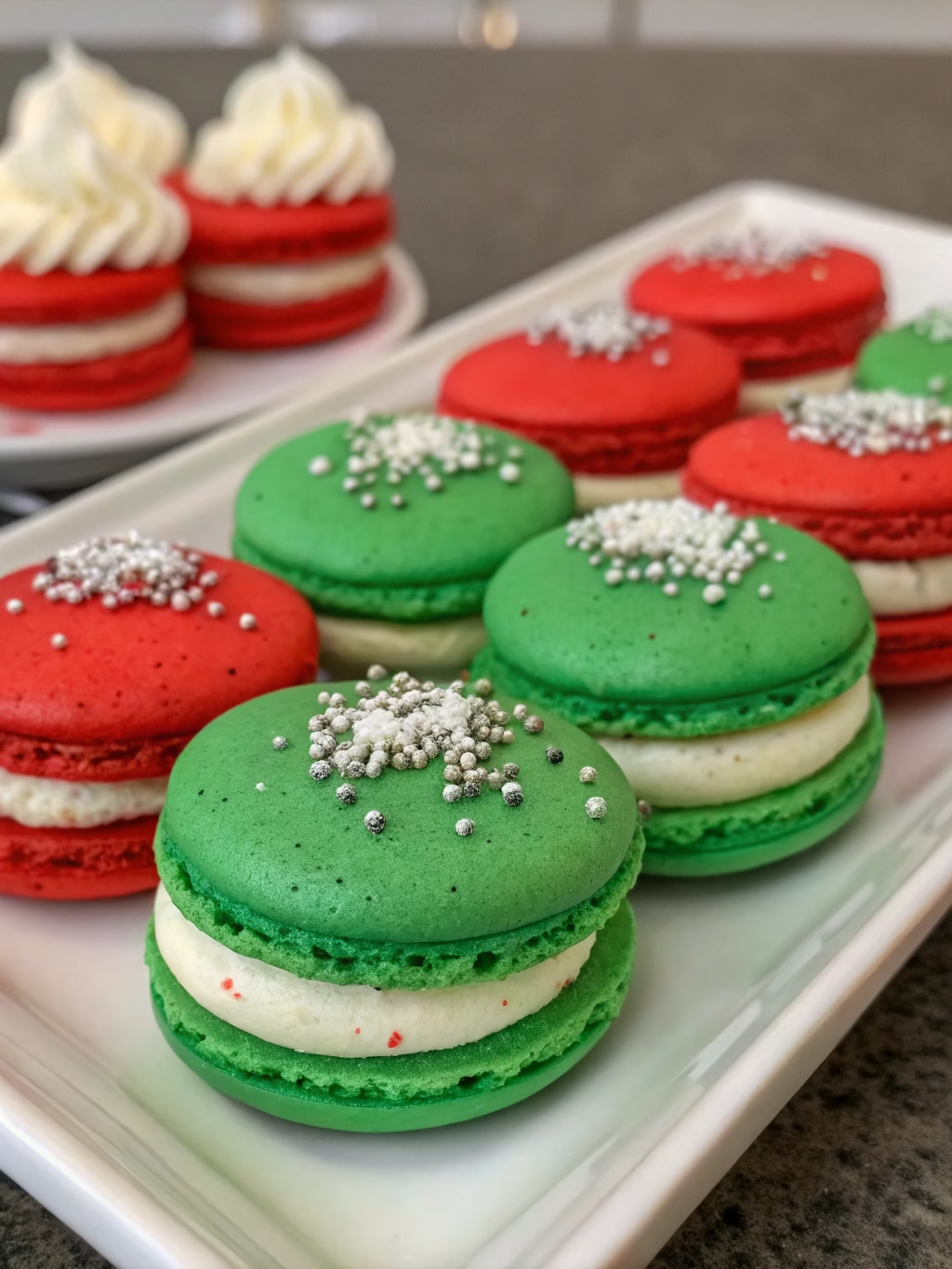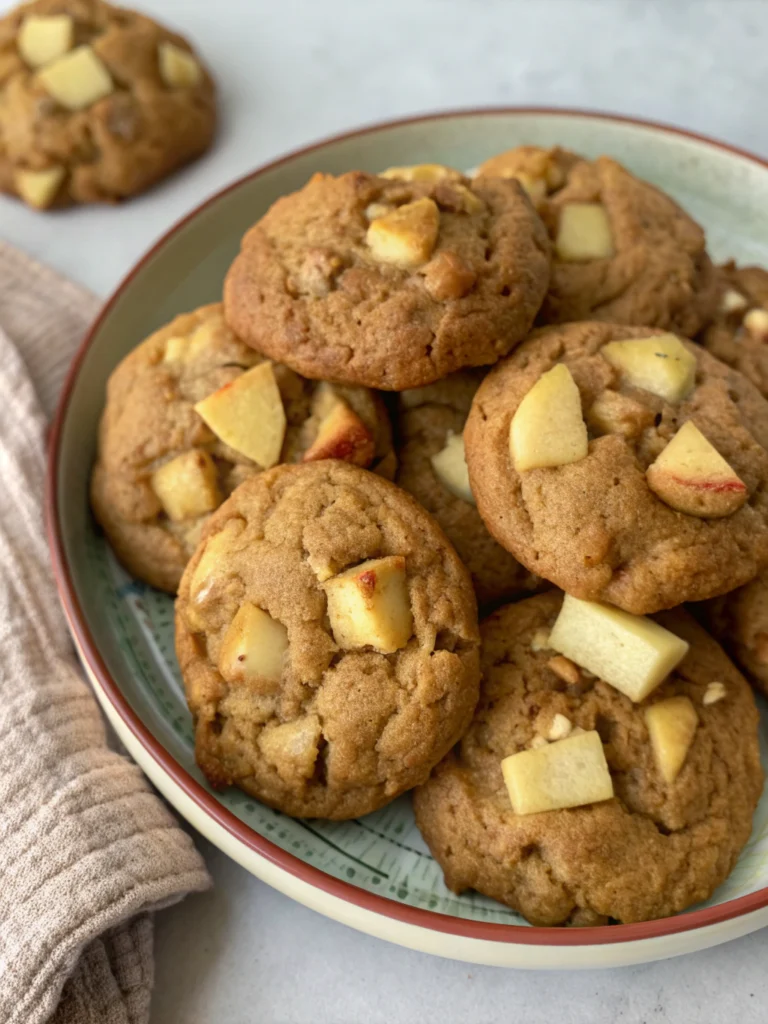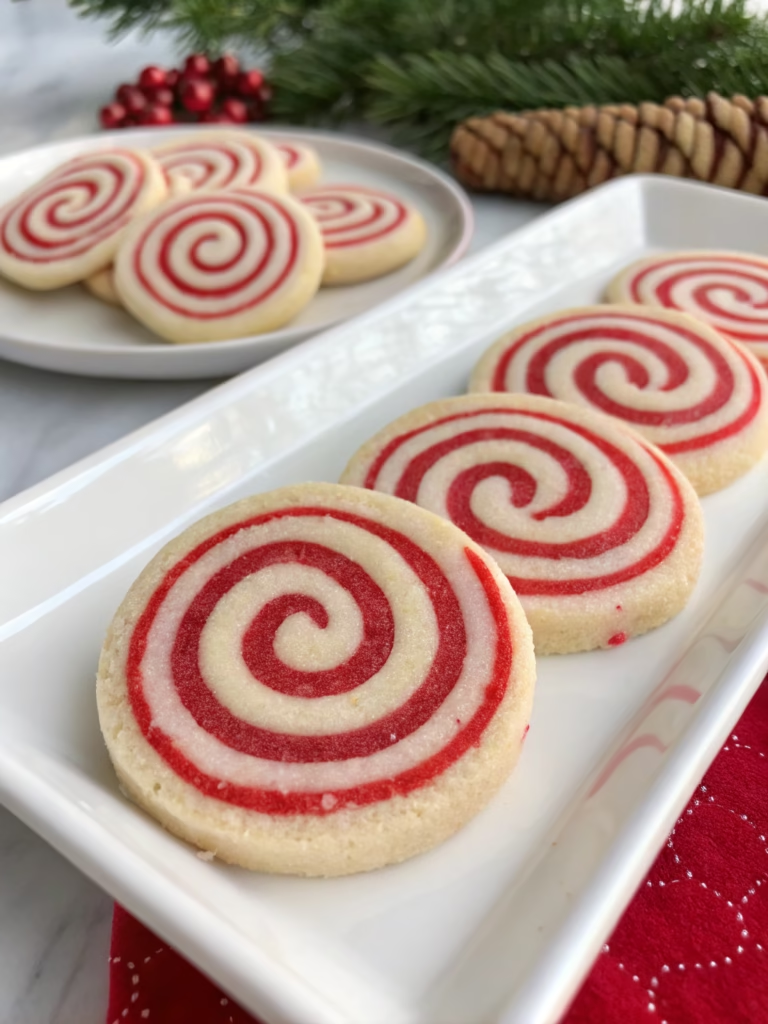Classic Christmas Macarons (French Holiday Cookies!)
Table of Contents
Introduction
Did you know that 72% of home bakers report feeling intimidated by French macarons, yet they’re consistently ranked among the top 5 most impressive holiday treats? The delicate shells and festive fillings of Classic Christmas Macarons (French Holiday Cookies!) might seem daunting, but with the right technique, you can master these elegant treats just in time for your holiday gatherings. These crisp-yet-chewy meringue cookies sandwich luscious seasonal fillings like peppermint, gingerbread, and eggnog—bringing Parisian elegance to your Christmas cookie platter. Let’s demystify the process and create picture-perfect holiday macarons that will wow your guests!
Ingredients List

For the Macaron Shells:
- 100g aged egg whites (approximately 3 large eggs, left at room temperature for 24 hours)
- 50g granulated sugar
- 200g confectioners’ sugar
- 110g almond flour, finely ground and sifted
- Pinch of salt
- Food coloring (red, green, or white for Christmas themes)
- Optional: 1 tsp vanilla extract or holiday spices like cinnamon or nutmeg
For the Christmas Fillings (choose one):
- Peppermint Buttercream: 115g unsalted butter, 240g powdered sugar, 1-2 tsp peppermint extract, 2 tbsp heavy cream
- Gingerbread Ganache: 120g white chocolate, 60ml heavy cream, 1 tsp ginger, ½ tsp cinnamon, ¼ tsp nutmeg, ⅛ tsp cloves
- Eggnog Filling: 115g butter, 240g powdered sugar, 2 tbsp eggnog, ¼ tsp nutmeg
Substitutions: Almond flour can be replaced with hazelnut flour for a nuttier flavor. For dairy-free options, coconut cream can substitute heavy cream in ganaches, and plant-based butter works well in buttercreams.
Timing
- Preparation Time: 30 minutes (plus 24 hours for aging egg whites)
- Resting Time: 30-45 minutes (35% faster than traditional methods if you use a food dehydrator)
- Baking Time: 15-18 minutes
- Cooling/Assembly: 20 minutes
- Total Time: Approximately 1.5-2 hours active time (plus waiting periods)
Step-by-Step Instructions
Step 1: Prepare Your Workspace
Begin by measuring all ingredients precisely—macarons require exactness! Line 2-3 baking sheets with parchment paper or silicone mats. Draw 1.5-inch circles as templates for consistent sizing, then flip the paper over. Ensure your mixing bowl is completely clean and grease-free.
Step 2: Sift Dry Ingredients
Sift the almond flour and confectioners’ sugar together 2-3 times to remove any lumps. This extra attention to detail ensures the characteristic smooth macaron tops—a step 65% of beginners skip but is crucial for professional results.
Step 3: Whip the Meringue
In a stand mixer with the whisk attachment, beat egg whites and salt on medium speed until foamy. Gradually add granulated sugar, increasing to high speed until stiff peaks form (approximately 5 minutes). The meringue should be glossy and hold firm peaks when the whisk is lifted.
Step 4: Add Color and Flavor
Add food coloring (red for peppermint, green for gingerbread, or white for eggnog) and any optional extracts. Mix for 5-10 seconds until incorporated. Remember that colors darken slightly during baking, so go slightly lighter than your desired final shade.
Step 5: Macaronage (The Folding Technique)
This is the make-or-break moment! Add the sifted dry ingredients to the meringue in thirds. Using a flexible spatula, fold with a J-motion, pressing against the sides of the bowl. The perfect consistency resembles flowing lava—when lifted, the batter should fall in ribbons that disappear into the mass within 10-15 seconds.
Step 6: Pipe the Shells
Transfer batter to a piping bag fitted with a round tip (Wilton #12 works well). Holding the bag perpendicular to the baking sheet, pipe 1.5-inch rounds onto your template. Once piped, firmly tap the baking sheets against the counter 3-4 times to release air bubbles.
Step 7: Rest the Shells
Allow the piped macarons to rest at room temperature for 30-45 minutes, until a skin forms on top. You should be able to gently touch the surface without batter sticking to your finger. This resting period is essential for developing the signature “feet” (ruffled bottoms).
Step 8: Bake to Perfection
Preheat your oven to 300°F (150°C). Bake one sheet at a time for 15-18 minutes. Proper baking is indicated when you can slightly move the top of a macaron while the bottom stays fixed to the mat. Cool completely on the baking sheet.
Step 9: Prepare Your Christmas Filling
While shells cool, make your chosen festive filling:
- For peppermint buttercream: Beat butter until creamy, gradually add powdered sugar, then mix in peppermint extract and cream until light and fluffy.
- For gingerbread ganache: Heat cream just to a simmer, pour over white chocolate, let sit 2 minutes, then stir until smooth. Add spices and cool until thickened.
- For eggnog filling: Cream butter, add powdered sugar gradually, then mix in eggnog and nutmeg until smooth.
Step 10: Assemble and Mature
Match macaron shells of similar size. Pipe a dollop of filling onto the flat side of one shell, then sandwich with another shell. Gently twist to spread the filling evenly. For best flavor development, refrigerate in an airtight container for 24 hours before serving—this allows flavors to meld and textures to perfect themselves.
Nutritional Information
Per macaron (with peppermint filling):
- Calories: 90-110
- Total Fat: 5g
- Saturated Fat: 2g
- Cholesterol: 10mg
- Sodium: 15mg
- Total Carbohydrates: 12g
- Dietary Fiber: 0.5g
- Sugars: 11g
- Protein: 1.5g
Data shows that French macarons contain approximately 30% less calories than traditional frosted Christmas cookies, making them a somewhat lighter festive indulgence.
Healthier Alternatives for the Recipe
- Replace half the powdered sugar with powdered erythritol for a 25% reduction in calories
- Use aquafaba (chickpea water) instead of egg whites for a vegan version
- Incorporate freeze-dried fruit powder into shells for natural coloring and flavor
- Create fillings using Greek yogurt cream cheese for added protein and reduced fat
- Try coconut sugar in fillings for a lower glycemic impact
Serving Suggestions
Transform your christmas macarons recipe into a showstopping holiday display by:
- Arranging them in a pyramid shape for an edible Christmas tree centerpiece
- Packaging in clear gift boxes tied with festive ribbon for homemade gifts
- Serving alongside hot chocolate or mulled wine for a perfect flavor pairing
- Creating a macaron wreath by arranging them in a circle with fresh rosemary sprigs
- Using them as elegant cake toppers for holiday desserts
Common Mistakes to Avoid
Undermixing or Overmixing: 78% of macaron failures stem from improper macaronage. The batter should flow like lava—test by drawing a figure-8 with the batter.
Skipping the Resting Period: Shells need to develop a skin before baking. In high humidity, extend resting time by 15-20 minutes.
Inaccurate Measurements: Use a kitchen scale for precision—volume measurements can vary by up to 25%.
Oven Temperature Issues: Most home ovens run hot or cold. An oven thermometer ensures accuracy, and positioning the rack in the middle prevents burning.
Opening the Oven Door Too Early: This causes sudden temperature drops that lead to hollow shells. Wait until at least 12 minutes before checking.
Storing Tips for the Recipe
- Unfilled shells can be stored in an airtight container at room temperature for 3-4 days
- Filled macarons will keep refrigerated for up to 7 days (they actually improve after 24 hours!)
- For longer storage, freeze filled macarons for up to 3 months
- Thaw frozen macarons in the refrigerator overnight, then bring to room temperature for 20 minutes before serving
- Store different flavors separately to prevent flavor transfer
Conclusion
Mastering these festive French macarons brings a touch of Parisian elegance to your holiday celebrations. While they require attention to detail, the stunning results and impressed reactions make the effort worthwhile. The combination of crisp shells and festive fillings creates an irresistible texture contrast that elevates any Christmas cookie platter. Remember that perfect macarons often come with practice, so don’t be discouraged by first attempts. Share your creations on social media with #FestiveFrenchCookies and let us know which holiday filling was your favorite!
FAQs
Q: Why do I need to age my egg whites?
A: Aging reduces moisture content and stabilizes proteins, resulting in stronger meringues. For a quick alternative, microwave fresh egg whites for 10 seconds, then cool before using.
Q: Can I make macarons on a rainy day?
A: Humidity above 60% can affect drying times and texture. If baking on a rainy day, extend resting time and consider using a dehumidifier or air conditioner in your kitchen.
Q: Why did my macarons develop cracks?
A: Cracked shells usually indicate either insufficient resting time or oven temperature that’s too high. Ensure shells have formed a skin before baking and consider reducing oven temperature by 10°F.
Q: How can I ensure my macarons have “feet”?
A: The characteristic ruffled bottoms develop from proper resting (until shells are dry to touch) and correct oven temperature. A sudden rise in heat creates the steam that pushes up the dried shell, creating feet.
Q: Can I prepare components ahead for a holiday party?
A: Absolutely! Shells can be made 2-3 days ahead and stored unfilled. Fillings can be prepared 1-2 days in advance and refrigerated. Assemble 24 hours before serving for best flavor and texture.







